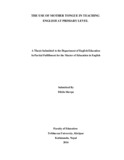Please use this identifier to cite or link to this item:
https://elibrary.tucl.edu.np/handle/123456789/1538| Title: | The Use of Mother Tongue in Teaching English at Primary Level |
| Authors: | Sherpa, Dikila |
| Keywords: | Teaching English;Mother Tongue;Primary Level;Education |
| Issue Date: | 2016 |
| Publisher: | Faculty of Education Tribhuvan University, Kirtipur Kathmandu, Nepal |
| Abstract: | This research work entitled The Use of Mother Tongue in Teaching English at Primary Level is an attempt to find out the role of using mother tongue for teaching English. This research also attempts to study the advantages and disadvantages of using mother tongue in teaching English. The researcher collected the data by distributing the questionnaires to altogether 20 parents and 20 teachers from six different primary schools of Taplejung district. The samples of this data were selected through purposive non- random sampling. Two sets of questionnaires were used to gather the data. The obtained data have been analyzed in order to meet the objectives of the study. The major finding shows that the role of mother tongue in teaching English at primary level is vital. The teachers used the mother tongue for cultural translation and breaking the monotony of the students in the classroom. Moreover, it has been perceived that mother tongue is used to find out the main idea of the text in shorter time but it hinders to develop communicative competence in the target language on the part of learners and students become habituated to learn only through mother tongue even in the great level (i.e. grade 6- 10). This thesis consists of five chapters. The first chapter is introduction of the study. The introduction consists of background of the study, statement of the problem, objectives of the study, significance of the study, delimitations of the study and operational definition of the key terms. The chapter two deals the review of theoretical literature that consists of review of theoretical and empirical literature including conceptual framework. Likewise, the third chapter of this study consists of the methods and procedures of the study. The design of the study, population and sample, sampling procedure, data collection tools, data collection procedures also included in chapter three. Similarly, the fourth chapter includes the product of the analysis and interpretation of the data. Furthermore, chapter five includes conclusions and recommendations made based on the findings. Finally, the references and the appendixes, which are necessary for the validation of the research, have also presented. |
| URI: | http://elibrary.tucl.edu.np/handle/123456789/1538 |
| Appears in Collections: | English Language Education |
Files in This Item:
| File | Description | Size | Format | |
|---|---|---|---|---|
| Dikila Sherpa Thesis 2016.pdf | 268.19 kB | Adobe PDF |  View/Open |
Items in DSpace are protected by copyright, with all rights reserved, unless otherwise indicated.
